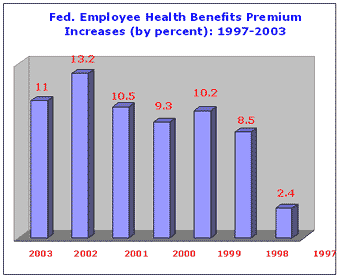The US Office of Personnel Management (OPM) recently announced “positive news for federal employees and retirees” (their words, not ours) regarding health benefits premiums. The increase in premium costs for 2003 will be “only” 11%. While every cloud may have a silver lining, this “positive news” may seem more like a rain storm to those affected since this is another large increase on top of similar increases for the past five years (you can read OPM press releases on health benefits increases from the links on the side of this article).
This latest jump of 11 percent has become routine with an average increase of more than 10% each year since 1998.
 OPM is apparently trying to soothe the anger and frustration of employees and retirees created by another big surge in benefit premiums and to deflect criticism of the agency as a result of negotiating the recent increase. OPM says that Americans in the private sector will be paying about 20% for health insurance benefits next year.
OPM is apparently trying to soothe the anger and frustration of employees and retirees created by another big surge in benefit premiums and to deflect criticism of the agency as a result of negotiating the recent increase. OPM says that Americans in the private sector will be paying about 20% for health insurance benefits next year.
Of course, OPM has some advantages in negotiating for the largest “employer-sponsored health insurance program in the nation” and it is apparent that the agency isn’t pleased with the situation. Addressing the National Association of Retired Federal Employees (NARFE) OPM Director Kay Coles James announced a plan to limit future increases.
The current plan for reducing future rate increases is:
- OPM Director meeting with OPM’s negotiating team to encourage tough negotiations with carriers on behalf of FEHB enrollees
- challenging health carriers to contain costs and maintain benefits
- performing an independent audit to look at the cost of all types of mandates on health care
- collaborating with OPM’s Inspector General to end fraud and waste in the program.
You can also read another OPM plan to control “future” health benefits increases by reading the 1999 press release issued when announcing a 9.3 increase for 2000. In that release, OPM Director Janice LaChance said the agency would control increases by raising standards for participation in the plan and to achieve efficiency and economy by contracting directly for selected benefits.
The continuing yearly double-digit increases aren’t unexpected. George Nesterczuk, former Staff Director of the House Civil Service Subcommittee warned two years ago that OPM was creating a Cadillac of health plans by inserting new requirements into plans rather than giving employees a choice of plans with fewer benefits.
Presumably, the plan announced by OPM Director James will be looking at whether these mandates should be retained and possibly offering plans with fewer options as a way of holding down the surge in benefit costs.
Federal retirees, who often need their health benefits more than younger Federal employees, are feeling the squeeze for a couple of reasons. Their cost of living increase has been about 3%. Retirees obviously don’t get raises in the form of within-grade increases or grade increases. And, while current Federal employees are able to pay their health benefits out of pre-tax income, retirees are not able to do that. This translates to higher costs and less pay each year.
The current tax code allows active Federal employees to pay for health benefits out of pre-tax income. In real terms, this saves the average Federal employee more than $400 per year by lowering taxable income by the amount of an employee’s health care premium. This “premium conversion plan” is not available to retired Federal employees.
One retired Federal executive expressed her frustration with the continuing double-digit increase in health benefits premiums when commenting: “At this rate, my entire annuity will be going to pay my health benefits premiums.”
While it won’t happen in the next few years, a differential between COLA increases and FEHB premium increases of more than 7% would eventually lead to most of an employee’s pension going to pay for health benefits.
The National Association of Retired Federal Employees (NARFE) is seeking legislation to provide the “premium conversion plan” for retirees as well as for current Feds.
As baby boomers near retirement, the Federal benefits program is reeling under a surge of costs as it faces this demographic bulge. OPM will have to make tough decisions on how to balance benefits and hold down costs as demands for service by an aging workforce rise and as costs spiral.


